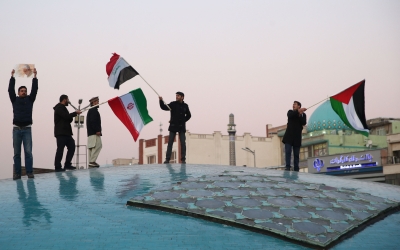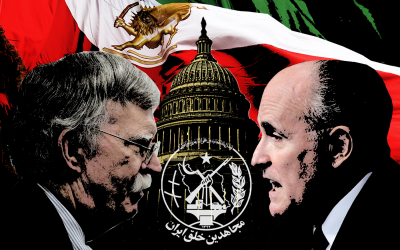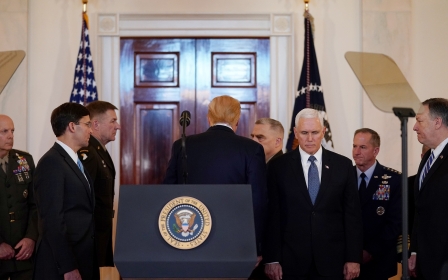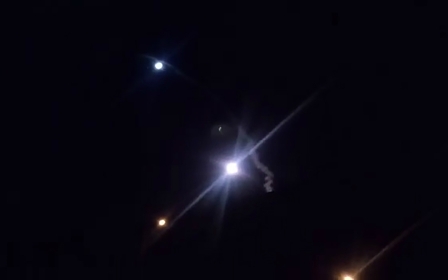Missile diplomacy: How Iran showcased its military capabilities without starting a war
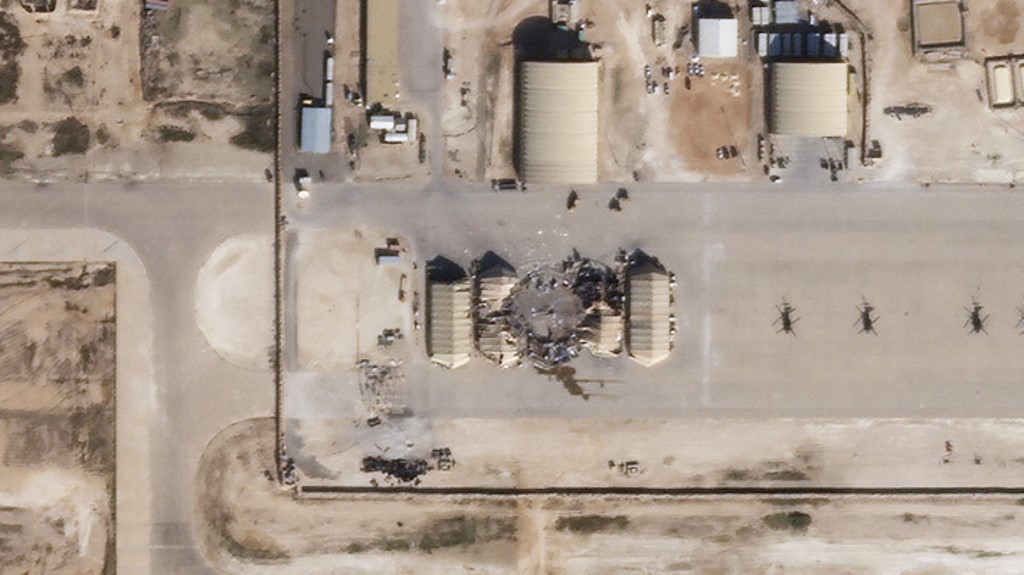
The “severe revenge” that Iran had promised in response to the US assassination of Qassem Soleimani finally came in the early hours of 8 January, exactly five days after the country’s most prominent general was taken out by American missile strikes.
At least 17 Iranian missiles hit the Ain al-Assad military base, one of the main facilities used by US and anti-Islamic State coalition forces in western Iraq, while another five missiles struck a US base near Erbil in Iraq’s semi-autonomous Kurdish region.
No one was killed in the assault, but satellite images showed damage to buildings and infrastructure at Ain al-Assad, with analysts spoken to by MEE hailing the apparent precision of the strikes as an "amazing achievement".
The carefully calibrated retaliation has sparked off a vigorous debate regarding the strategic calculus as well as military capabilities of Tehran in general and the elite Islamic Revolutionary Guards Corps (IRGC) in particular.
After all, why did a missile salvo of such scale and significance result in no apparent casualties, despite claims to the contrary by Iranian defence officials and state-affiliated media?
Was it in fact Iran’s intention to avoid hurting anybody? And, if so, what does that mean for the credibility of its retaliation?
Comments by some Iranian officials themselves have not helped to clear up the ambiguities surrounding the intention of the strikes.
“We did not seek to kill anyone in this operation, even though tens of people must have certainly been killed or wounded,” General Amir Ali Hajizadeh, head of the IRGC’s Aerospace Division, told reporters on Thursday.
Hajizadeh went on to suggest that Iran could have carried out attacks that would have killed thousands of people if it had wished to do so, or if its initial attack had drawn a US response.
“If we were looking to kill, we could have designed the operation in a way such that 500 would be killed in the first step, and if they had responded, a further 4,000 to 5,000 would be killed in the next steps within 48 hours,” he said.
Multiple messages
US officials have also sent out mixed messages about the attacks, with some Trump administration insiders telling CNN that they believed that Iran had shot to miss.
But General Mark Milley, Chairman of the Joint Chiefs of Staff, told reporters in Washington on Wednesday: “I believe based on what I saw and what I know that they were intended to cause structural damage, destroy vehicles and equipment and aircraft, and to kill personnel.”
While the Iraqi government had received word from Tehran of the missile attacks shortly before they were launched - and notified American forces immediately - Milley and other US officials have said that it was early warning systems and other precautionary measures that enabled them to evade lethal hits.
“Iran’s decision to retaliate directly against the US while seeking to avoid casualties is sending multiple messages at once,” Nicholas L Miller, professor of government at Dartmouth College and author of Stopping the Bomb: The Sources and Effectiveness of US Nonproliferation Policy, told MEE.
“It’s signalling to its own domestic audience that it has secured a measure of revenge for Soleimani’s killing. To the United States, it’s signalling resolve while at the same time leaving a pathway open for de-escalation.”
The retaliatory action was indeed greeted with jubilation by many Iranians who had taken personally the elimination of Soleimani - who was widely depicted as a national hero and honoured as a martyr after his death - and expected a decisive response.
But many also followed the unfolding saga with enormous apprehension, fearing that a reprise attack could invite bigger American retaliation and set in motion an uncontrollable spiral of military confrontations with grave consequences for their homeland and the region.
'It was a loss for both sides: Iran lost Soleimani, and the United States lost its stature in the region'
- Saeid Golkar, Iran researcher
"It was a good move for domestic political consumption and propaganda, as the government both preserved its prestige and avoided American casualties, hence a compelled response from the Trump administration,” Saeid Golkar, a researcher studying Iran's Revolutionary Guard Corps at the University of Tennessee at Chattanooga and author of Captive Society: The Basij Militia and Social Control in Iran told MEE.
“I would say it was a loss for both sides: the Islamic Republic lost Soleimani, and the United States lost its stature in the region. By the same token, it was also a mutual win, as both sides achieved part of what they wanted and yet managed to dodge war.”
Meanwhile, the efficacy and accuracy of Iran’s missile strikes seem to have taken many off guard, perhaps even Iranian leaders and military commanders themselves.
“They scored some incredibly precise hits visible on satellite pictures. Now did they try to avoid casualties? They surely did not hit living quarters,” Fabian Hinz, a missile expert at the James Martin Center for Nonproliferation Studies in California, told MEE.
“Hitting a single small building is normal when you have an RPG [rocket-propelled grenade], but an amazing achievement with a ballistic missile.”
In an unusually nervous and jittery address following the attacks, US President Donald Trump used the fact that no Americans had been harmed in the attack to justify his decision to stand down from further confrontation, striking a conciliatory tone that stressed the need for all to “work together toward making a deal with Iran”.
Trump once again attacked the Obama administration’s 2015 nuclear deal with Tehran - officially known as the Joint Comprehensive Plan of Action (JCPOA) - describing it as “very defective”, and called on Iran to “abandon its nuclear ambitions and end its support for terrorism”.
He also failed to distinguish between the Iranian people and their government, despite noting earlier in his speech that 1,500 people had been killed by security forces during widespread protests in November.
“Finally, to the people and leaders of Iran: we want you to have a future and a great future, one that you deserve, one of prosperity at home in harmony with the nations of the world,” said Trump.
'Encouraging intelligence'
Yet some positive signs of a mutual willingness to deescalate tensions have already emerged. In a rare about-turn, US Secretary of State Mike Pompeo ordered American diplomats and diplomatic missions abroad to restrict their contact with several Iranian opposition groups including the Mujahedin-e Khalq Organisation (MEK).
MEK was listed as a terrorist group by the United States until 2012 but more recently it has courted influence in Washington, with John Bolton, Trump’s former national security adviser, and Rudy Giuliani, Trump’s personal lawyer, both accepting hefty fees to speak at MEK events, and lawmakers from both sides of the aisle lauding the group as a pro-democracy movement.
“Direct US government engagement with these groups could prove counterproductive to our policy goal of seeking a comprehensive deal with the Iranian regime that addresses its destabilising behaviour,” Pompeo said.
For its part, the Islamic Republic has reportedly urged pro-Iran militia forces in the region to restrain themselves from actions against American interests and targets until the dust from the latest escalation has settled.
“We're receiving some encouraging intelligence that Iran is sending messages to those very same militias not to move against American targets or civilians, and we hope that that message continues to echo,” US Vice President Mike Pence told CBS News in an interview.
Yet Tehran is unlikely to change course as long as the US policy of “maximum pressure” against it persists unabated and prepares the ground for a domestic revolt against the power structure in place since the 1979 revolution that established the Islamic Republic.
Tehran’s response so far has been a policy of “maximum resistance”, from unattributable attacks on oil tankers in the Persian Gulf to the abandoning on 5 January of almost all of the JCPOA restrictions on its nuclear programme.
That is likely to continue in unconventional and asymmetrical ways, most probably with the assistance of its non-state allies in the region, who include Hezbollah in Lebanon, the Hashd al-Shaabi militias in Iraq and the Houthis battling a US-backed Saudi-led coalition in Yemen.
Following the missile strikes, Iranian Supreme Leader Ayatollah Ali Khamenei asserted in a speech that this “slap on the face” had been only one blow in a broader scheme of retaliation for the killing of Qassem Soleimani.
“Ultimately, unless the Trump administration begins easing up on its maximum pressure campaign and pursues de-escalation," said Professor Miller of Dartmouth College, "we can expect to see continued Iranian provocations, each of which carries some risk of escalation.”
Middle East Eye propose une couverture et une analyse indépendantes et incomparables du Moyen-Orient, de l’Afrique du Nord et d’autres régions du monde. Pour en savoir plus sur la reprise de ce contenu et les frais qui s’appliquent, veuillez remplir ce formulaire [en anglais]. Pour en savoir plus sur MEE, cliquez ici [en anglais].


